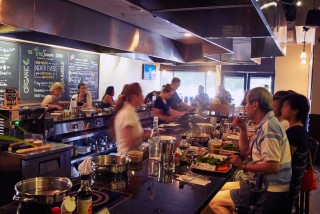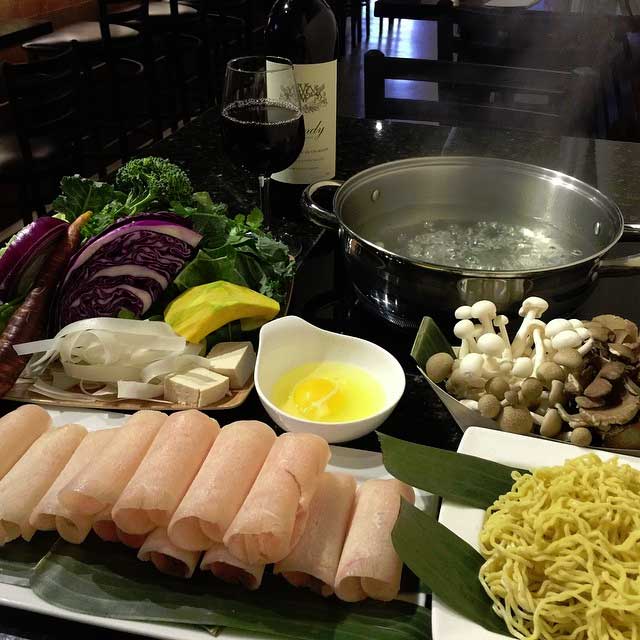SHABU-SHABU (ALSO SPELLED SHYABU-SHYABU) IS A JAPANESE DISH FEATURING THINLY SLICED BEEF COOKED IN WATER.
The term is an onomatopoeia, derived from the sound emitted when the ingredients are stirred in the cooking pot. Thinly sliced meat and vegetables are served with dipping sauces.Hot pot, (also known as steamboat in Singapore, Malaysia, Thailand, the Philippines and Brunei), refers to several East Asian but most often refers to the Chinese variety of stew, consisting of a simmering metal pot of stock at the center of the dining table. While the hot pot is kept simmering, ingredients are placed into the pot and are cooked at the table. Typical hot pot dishes include thinly sliced meat, leaf vegetables, mushrooms, wontons, egg dumplings, and seafood.Vegetables, fish and meat should be fresh. Though we most times think of dining out to enjoy hot pot dishes, a variety of appliances are available for purchase so you can use the same technique at home.
HISTORY
Shabu-shabu was introduced in Japan in the 20th century with the opening of the restaurant “Suehiro” in Osaka, where the name was invented. Its origins are traced back to the Chinese hot pot known as instant-boiled mutton (Shuàn Yángròu). Shabu-shabu is most similar to the original Chinese version when compared to other Japanese dishes. The Chinese hot pot has a history of more than 1,000 years and seems to have originated in Mongolia and the Jin Dynasty where the main ingredient was meat, usually beef, mutton or horse. It then spread to southern China during the Tang Dynasty and was further established during the Mongolian Yuan Dynasty. In time, regional variations developed with different ingredients such as seafood. By the Qing Dynasty (AD 1644 to1912), the hot pot became popular throughout most of China. Today in many modern homes, particularly in the big cities, the traditional coal-heated steamboat or hot pot has been replaced by electric, propane, butane gas, or induction cooker versions.
PREPARATION
These dishes were originally made with thinly sliced beef, but some menus today offer pork, crab,chicken, lamb, duck, or lobster. Most often, ribeye steak is used, but less tender cuts, such as top sirloin, are also common. A more expensive meat,such as wagyū, may also be used. It is usually served with tofu and vegetables, including Chinese cabbage, chrysanthemum leaves, nori (edible seaweed), onions, carrots, and mushrooms. In some places, udon, mochi or harusame noodles may also be served. Meat or vegetables are loaded individually into the hot cooking water or dashi (broth) by chopsticks, and cooking time can take from 1 to 15 minutes, depending on the type of food. Meat should be cooked at the very least 20 seconds depending on the thickness of meat. Broth selections vary and can include miso, lemongrass, mushroom, and kelp. The cooking pot is often sunk into the table and fueled by propane. Or alternatively above the table and fueled by a portable butane gas stove or hot coals.
SAUCES AND DIPS
Sauces can be used to dip meats and vegetables when eating shabu-shabu or hot pot and they vary between the locations of origin and the whims of the restaurateurs. Sauces include ponzu, goma(sesame) and pomegranate. Condiment options such as spring onions and Japanese pickled carrots are also often offered so that customers can make the sauce according to their own preferences. Cooked meat and vegetables are usually dipped in ponzu or goma (sesame seed) sauce before eating, and served with a bowl of steamed white rice. Once the meat and vegetables have been eaten, leftover broth from the pot is customarily combined with the remaining rice, and the resulting soup is usually eaten last.
Source: wikipedia.org
 True Seasons Organic Kitchen
True Seasons Organic Kitchen
What style do you serve/prepare? We offer organic hot pot.What is the style of cooking? It’s soup cooked in a hot pot at the table with a variety of fresh ingredients and flavorful dipping sauces.
What sets that style of cooking apart from mainstream full service restaurants? It is free of oil and dairy, it can be gluten free and modified for many food sensitivities and it’s fun and interactive, as guests mix and match different ingredients to their liking. Guests see the fresh ingredients come together to create exciting and delicious flavors. It’s a great way to enjoy the flavors of truly fresh and quality ingredients, as there is so little processing of the food.
What sets your restaurant apart in the marketplace of restaurants with the same style of cooking? With very few exceptions, all our food is organic, with non-GMO ingredients from local sustainable growers. We match the quality of the ingredients with a high level of service and a passionate knowledge of the food and where it comes from. We love to share with our guests why the food they are enjoying is not only delicious, but also thoughtfully sourced, clean and healthy.What is the average cover per person including drinks? $25














